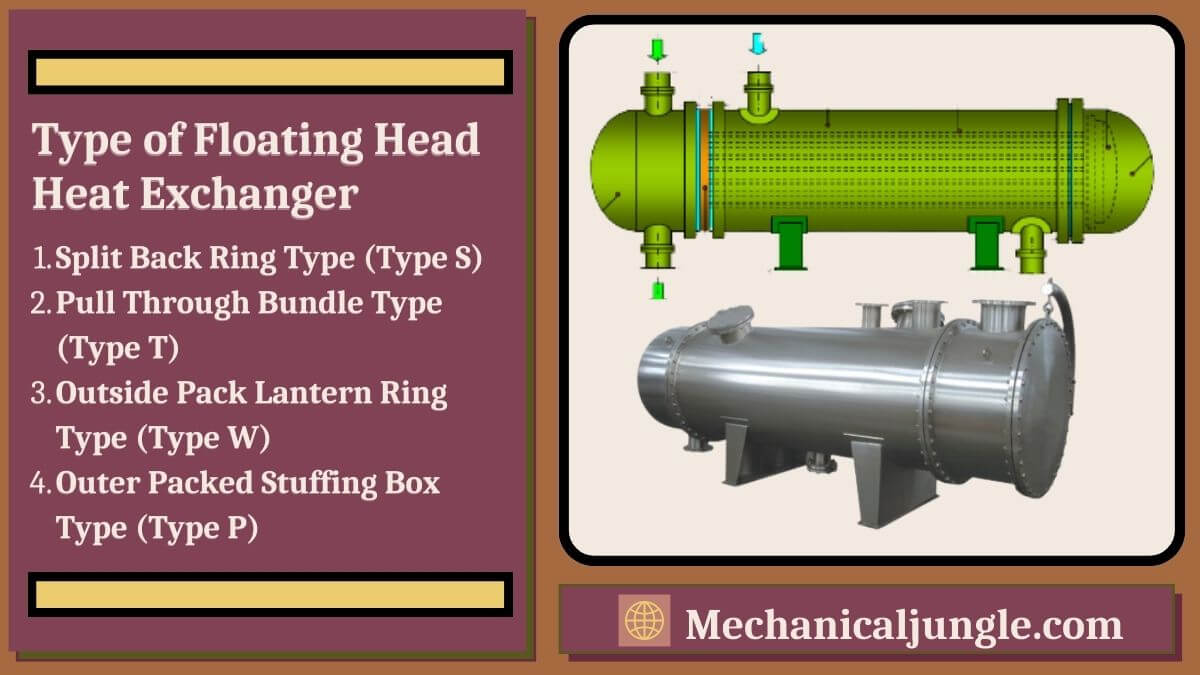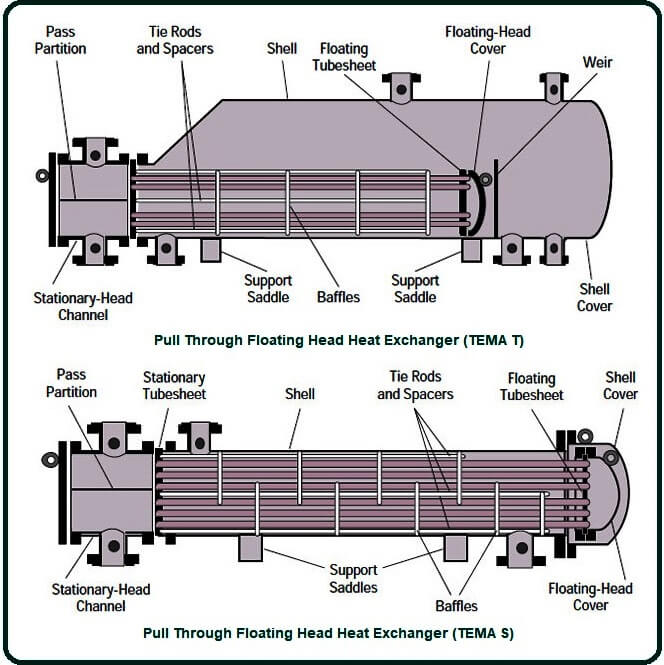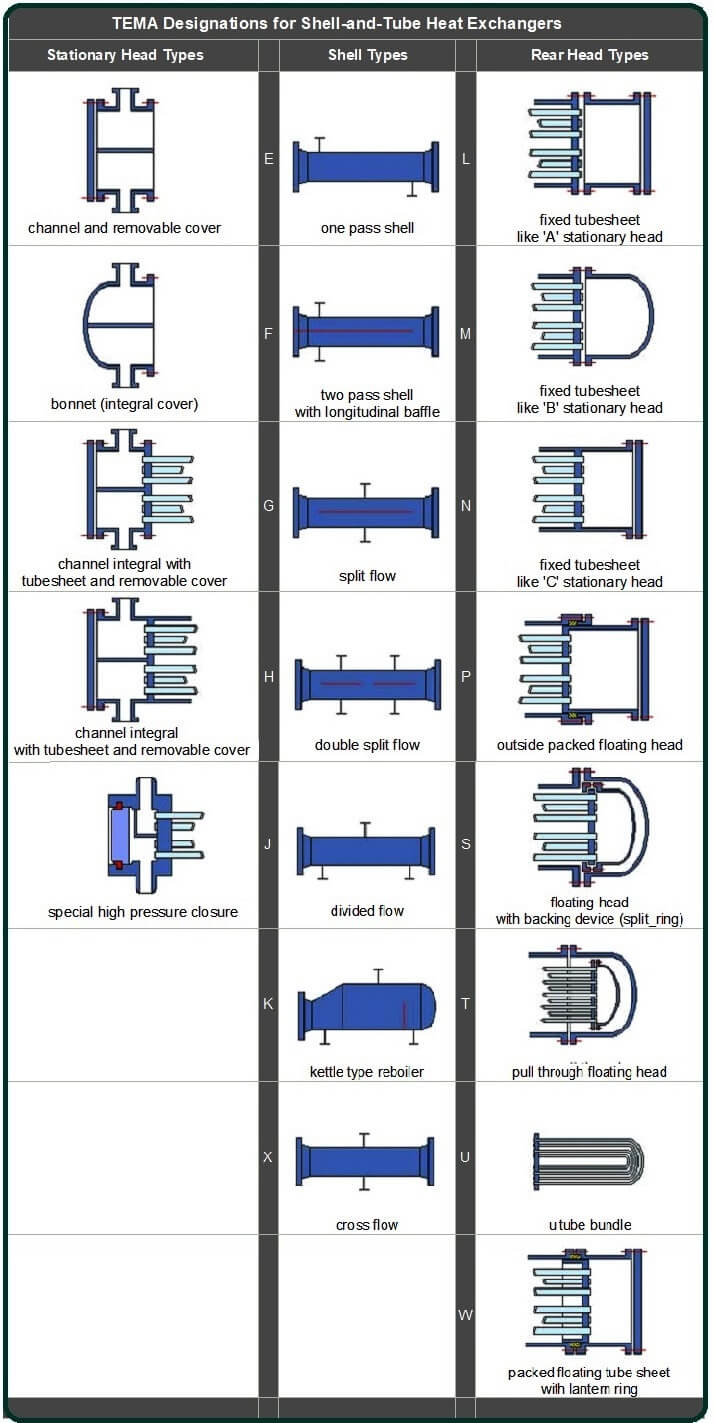
Floating Head Heat Exchanger:

A floating head heat exchanger is one of the most commonly used heat exchangers. As shown in its name, in this design, one end of the tube sheet is attached to the shell, while the other can “float” freely inside the shell.
Normally, both the shell and the tube bundle are free from expansion, thus causing no thermal stress between the shell and the tube bundle when the temperature difference of the two mediums is large.
In addition, the heat exchanger is easy to inspect and clean mechanically because the tube bundle can be removed at all. Floating head heat exchangers are widely used for service where the temperature is high between shell and tube bundle, or dirty service such as petroleum refinery.
With high reliability & wide adaptability, the floating head heat exchanger has accumulated a wealth of experiences during the process of long-term use and has promoted its development continuously.
So far, among all types of heat exchangers, the floating head heat exchanger is still in the leading position. A floating head type heat exchanger is a type of shell and tube heat exchanger in which the tube sheet assembly is free and free to move within the shell or shell cover.
These exchangers are widely used for the service where the temperature between the shell and the tube bundle is high, which creates expansion issues. The floating head exchangers are the best heat exchangers in terms of efficiency & maintenance but inherently comes at a high cost.
With high reliability & wide adaptability, the floating head heat exchangers have accumulated a wealth of experiences during the process of long-term use and promoted their development continuously.
So far, among all types of heat exchangers, the floating head heat exchanger is still in the leading position.
This type of heats exchanger can be applied as a solution:
- High thermal efficiency
- Corrosive air currents
- Cooling applications
- High temperature
Floating Head Heat Exchanger Design:

According to different requirements, floating head on a floating head heat exchanger can be designed into different types; in addition to considering that the tube bundle can move freely within the device, we also take the convenience of maintenance, installation, and cleaning needed for heat exchanger.
Generally, there are fours basics types of floating head heats exchanger – packed stuffing box (TEMA P), outer packed lantern ring (TEMA W), floating head with a backing device (TEMA S), and pull through (TEMA T). Design.
ANSON can manufacture different types of floating head heat exchangers according to TEMA, API660, and JISB8249. Other special requirements are also available.

Parts of Floating Head Heat Exchanger:
To answer the question of what a floating head heat exchanger is, let’s look at what its different parts are. As shown in its name, in this design, one end of the tube sheet is attached to the shell, while the other can “float” freely inside the shell.
It also has a removable tube bundle which is composed of a straight tube, tube sheet, tie rod and baffles. Depending on the weight & length of the bundle, there may also be slide or wheel assemblies to facilitate the removal of the tube bundle from the heat exchanger shell.
The floating tube sheet must be attached to the floating headcover. In this device, the gasket joints are very large, so it is expensive.
Normally, both the shell and the tube bundle are free from expansion, allowing that no thermal stress is generated between the shell and the tube bundle when the temperature difference of the two mediums is large.
Working Principle of Floating Head Heat Exchanger:
The working principles of this type of heat exchanger are simple. When the tube’s side allowable pressure drop is low enough & fluid cannot be pumped to the shell side, floating head heat exchangers are recommended.
The tube-side allowable pressures drop becomes the limiting factor in determining the length & number of tubes, and the shell-side pressure drop is maximized by a baffle arrangement within the size that will achieve the required performance.
Type of Floating Head Heat Exchanger:
According to different requirements, the floating head on the floating head heat exchanger can be designed into different types.
To reduce thermal stress and provide a means to remove the tube bundle for cleaning, a number of floating head designs have been installed. Here are the four basic types of floating head heat exchangers:
#1. Split Back Ring Type (Type S)
Split back ring-type units are commonly used in industries. In these types of constructions, the floating head is fitted into the tube sheet that faces away from the channel. The floating heads are held in position by split backing rings so that dismantling is possibles.
The diameter of the floating tube sheet is kept slightly smaller than the inner shell diameter so that the entire tube bundles can be removed from the end of the channel.
The shell is closed by bonnets on the floating head side. The split-rings type also has a “pull-through” feature associated with the pull-through bundle type of a floating head heat exchanger. It is recommended for high-pressures, non-hazardous process fluids.
Professionals
- High pressure is possible.
- Differential expansions are provided by the floating head.
- Shell and tube mechanical cleaning are possible.
- The tube bundle is removable.
Shortcoming
Gasket failure is not visible externally, so the leak may go undetected for some time.
#2. Pull Through Bundle Type (Type T)
In the pull-throughs bundle’s type, one of the tubes sheets is made shorter so that it can be pulled through the shell. This allows access to the insides of shells so that they can be inspected, repaired and cleaned.
However, this design has fewer tubes than others, which means it transfers heat more slowly. There are fewer tubes to accommodate the bonnet flange & bolt circle.
Professionals
- The tube bundle is removable. (individual tubes too)
- Differential expansions are provided by the floating head.
- Mechanical cleaning of shell and tube sides is possible.
- Double tube sheets are possible.
Shortcoming
- The seal is not visible externally; Hence the leak may not be detected for some time.
- This type will be more expensive than other types.
#3. Outside Pack Lantern Ring Type (Type W)
In this type, the shell side and the tube side stream are sealed separately by separate packing and separated by a lanterns ring. These are the lowest costs of the floating head design. This type is recommended for low pressures, low temperature & non-hazardous liquids.
Professionals
- The spatial expansion between tubes is possible via the floating head design, therefore eliminating the need for a development joint.
- The tube bundle is removable. (individual tubes too)
- Tube side mechanical cleaning is possible.
- Mechanical cleaning of the shell side is possible.
Shortcoming
- Only two tube side passes are possible at most.
- Leakage from the shell and tube sides is possible.
- A maximums temperature of 375 degrees Fahrenheit & a maximum pressure of 300 psi limits the use of these units at high pressures and temperatures.
#4. Outer Packed Stuffing Box Type (Type P)
In this type, a skirt attached to the floating tube sheet passes through the backs end of the shell. The space between the skirt & the shell is sealed by several layers of packing and packing gland.
Unlike the outer-pack lantern ring design, it includes four tubes and not two, making it quick to transfer heat from medium to medium. It is recommended for low pressures, low temperatures non-hazardous liquids.
Professionals
- High pressure on the tube sides is possible.
- The tube bundles are removable. (individual tubes too)
- Shell and tube mechanicals cleaning is possible.
- More than two tubes passes are possible to achieve an acceptable pressure drop.
- The packing failure is visible externally under operation.
- A double tube sheet is possible.
- Differential expansion is provided by packing.
Shortcoming
Dangerous materials should not be used on the shell side because of potential leakage. The packing will have a tendency to limit the shell fluid to temperatures below 300 degrees Fahrenheit and pressures below 150 psi. This type lacks positive sealing & thus is also prone to leakage.
Profit
- Tubes bundles can be pulled out to facilitate cleaning of the tube side and shell side.
- Temperatures differences between the two mediums are not limited.
- The heat exchanger can be operated under high temperature and high pressure; the average temperature is less than or equal to 450 ℃, and the pressure is less than or equal to 6.4MPa.
- These types of heats exchangers are suitable for serious scaling occasions.
- These types of heat exchangers are suitable for the easy occasion of corrosion.
- No temperature limit between two mediums
- Easy to clean and inspect
- High reliability and wide adaptability
- Suitable for serious scalping occasion
- Suitable for easy corrosion occasion
- Suitable for application of dirty liquids due to ease of cleaning
- The tube bundles can be removed for inspection.
- Possible mechanical cleaning of the outer surface of the tubes
- Since the tubes are straight, individual tubes can be changed.
- Expanding the tube and shell is no problem.
- The inside surface of the tube can be cleaned without removing the tube bundle.
- No limit on the number of tube side passes.
Limitations
- It is expensive compared to other heat exchangers.
- A large number of gasket joints
- Leakage can be a problem, as opposed to a U tube type heat exchanger due to the floating head.
- Installed horizontally only
- The packing material design creates limits on pressure and temperature.
- Tubes may not expand freely so as to avoid large thermal shock applications.
- It needs to be bolted to the tube sheet to provide a floating-head cover. Bolt circles require the use of a space where it will be possible to place a large number of tubes.
Application
These types of heats exchanger are widely used in various industries such as petrochemical plants and chemical industries. Some examples of this heat exchanger are as follows:
- Common industrial applications requiring frequent cleaning
- Chemical Processing Applications for Toxic Liquids
- Hydrocarbon Liquid Condenser
- Special gas aftercooler and intercooler
- Air Pollution Control System,
- Secondary heat recovery solutions for returning heat to ovens, dryers, kilns,
- Building Heating.
Frequently Asked Questions (FAQ) about Floating Head Heat Exchangers
What is a floating head heat exchanger?
A floating head heat exchanger is a type of shell and tube heat exchanger where one end of the tube bundle (tube sheet) is fixed to the shell while the other end is free to expand and contract within the shell. This design accommodates thermal expansion differences between the tube bundle and the shell, making it suitable for high-temperature and dirty service applications.
How does a floating head heat exchanger work?
The heat exchanger works by allowing the tube bundle to move freely within the shell, which prevents thermal stress buildup between the tube bundle and the shell during temperature variations. This design also facilitates easier maintenance and cleaning since the tube bundle can be removed from the shell.
What are the advantages of floating head heat exchangers?
- High thermal efficiency due to reduced thermal stress.
- Easy inspection and cleaning as the tube bundle is removable.
- Suitable for high-temperature and dirty service applications.
- Wide adaptability and reliability in various industrial applications.
What are the main types of floating head heat exchangers?
There are four basic types:
- Split Back Ring Type (Type S)
- Pull Through Bundle Type (Type T)
- Outside Packed Lantern Ring Type (Type W)
- Outer Packed Stuffing Box Type (Type P) Each type has specific design features and is suitable for different operating conditions and maintenance requirements.
Where are floating head heat exchangers commonly used?
Floating head heat exchangers find applications in:
- Petrochemical plants
- Chemical industries
- Air pollution control systems
- Heating applications in buildings
- Industrial processes requiring frequent cleaning or handling of corrosive fluids.
What are the limitations of floating head heat exchangers?
- Higher initial cost compared to some other types of heat exchangers.
- Potential for leakage due to gasket joints.
- Design limitations based on pressure and temperature ranges.
- Typically installed horizontally due to design constraints.
How do you select the right type of floating head heat exchanger for an application?
The selection depends on factors such as:
- Operating temperature and pressure requirements.
- Nature of fluids (clean, corrosive, high viscosity, etc.).
- Cleaning and maintenance frequency.
- Budget considerations and lifecycle costs.
What maintenance is required for floating head heat exchangers?
Regular maintenance includes:
- Inspection of gaskets and seals.
- Cleaning of tube bundle and shell side surfaces.
- Checking for corrosion or fouling.
- Periodic replacement of gaskets and packing materials.
Can floating head heat exchangers handle high-pressure applications?
Yes, depending on the design type (such as Type S or Type P), floating head heat exchangers can be designed to handle high-pressure applications effectively. It’s crucial to select the appropriate type based on the specific pressure and temperature requirements of the application.
How can I ensure optimal performance of a floating head heat exchanger?
Optimal performance can be maintained by:
- Following recommended maintenance schedules.
- Monitoring pressure differentials and temperature variations.
- Ensuring proper alignment during installation and reassembly.
- Using compatible materials for gaskets and packing according to the fluid properties.

